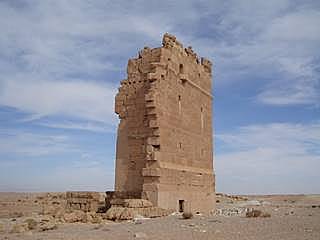
Qasr Alheer Algharbi
Encyclopedia

Palmyra
Palmyra was an ancient city in Syria. In the age of antiquity, it was an important city of central Syria, located in an oasis 215 km northeast of Damascus and 180 km southwest of the Euphrates at Deir ez-Zor. It had long been a vital caravan city for travellers crossing the Syrian desert...
on the Damascus road, is a twin palace with Qasr al-Hayr al-Sharqi; built by the Umayyad
Umayyad
The Umayyad Caliphate was the second of the four major Arab caliphates established after the death of Muhammad. It was ruled by the Umayyad dynasty, whose name derives from Umayya ibn Abd Shams, the great-grandfather of the first Umayyad caliph. Although the Umayyad family originally came from the...
caliph Hisham ibn Abd al-Malik
Hisham ibn Abd al-Malik
Hisham ibn Abd al-Malik 10th Umayyad caliph who ruled from 723 until his death in 743. When he was born in 691 his mother named him after her father....
in 727 CE. The architectural view was a Byzantine one.
It was used as an eye of the king during Umayyad era, to control the movement of the desert tribes and to be as a barrier against them, as well as being a hunting chalet. Later it was utilized by the Ayyubids and the Mamelukes but was abandoned permanently after the Mongol invasions.
The castle is quadrangle in outline with 70-meter sides. The central doorway to the castle is very attractive, and has been moved to the National Museum of Damascus
National Museum of Damascus
The National Museum of Damascus is a large museum in the heart of Damascus, Syria. The most popular part of the museum is the reconstruction of the 2nd century CE Dura-Europos synagogue.- Location :...
to be used as the entrance. Its semi-cylindrical towers on the sides of the doorway, columns, and the geometric shapes mirrored a blend of Persian, Byzantine
Byzantine
Byzantine usually refers to the Roman Empire during the Middle Ages.Byzantine may also refer to:* A citizen of the Byzantine Empire, or native Greek during the Middle Ages...
and Arab
Arab
Arab people, also known as Arabs , are a panethnicity primarily living in the Arab world, which is located in Western Asia and North Africa. They are identified as such on one or more of genealogical, linguistic, or cultural grounds, with tribal affiliations, and intra-tribal relationships playing...
architecture.
Not much remained from the castle. Only visible is reservoir to collect waters from Harbaka dam, a bath and a khan.
The gateway is presently preserved as a façade in the National Museum of Damascus.

